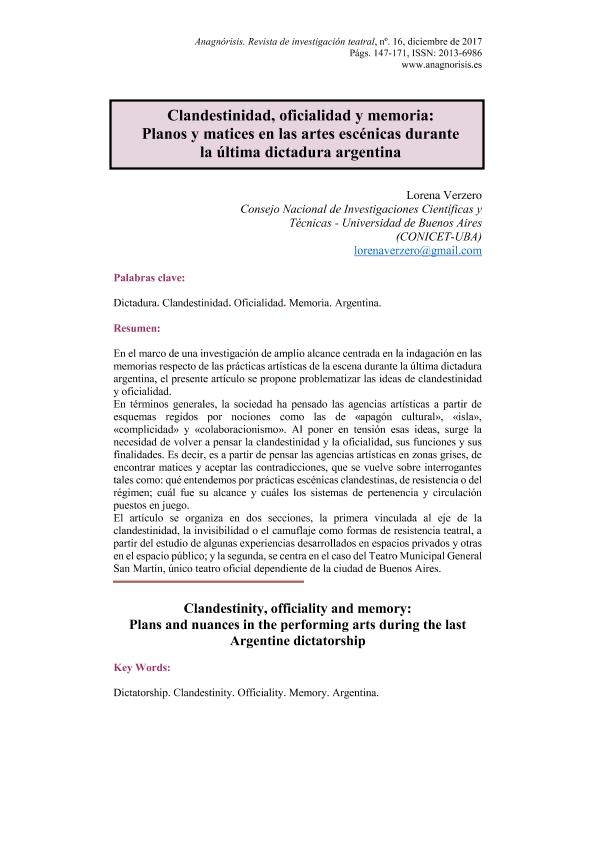Artículo
En el marco de una investigación de amplio alcance centrada en la indagación en las memorias respecto de las prácticas artísticas de la escena durante la última dictadura argentina, el presente artículo se propone problematizar las ideas de clandestinidad y oficialidad.En términos generales, la sociedad ha pensado las agencias artísticas a partir de esquemas regidos por nociones como las de «apagón cultural», «isla», «complicidad» y «colaboracionismo». Al poner en tensión esas ideas, surge la necesidad de volver a pensar la clandestinidad y la oficialidad, sus funciones y sus finalidades. Es decir, es a partir de pensar las agencias artísticas en zonas grises, de encontrar matices y aceptar las contradicciones, que se vuelve sobre interrogantes tales como: qué entendemos por prácticas escénicas clandestinas, de resistencia o del régimen; cuál fue su alcance y cuáles los sistemas de pertenencia y circulación puestos en juego.El artículo se organiza en dos secciones, la primera vinculada al eje de la clandestinidad, la invisibilidad o el camuflaje como formas de resistencia teatral, a partir del estudio de algunas experiencias desarrollados en espacios privados y otras en el espacio público; y la segunda, se centra en el caso del Teatro Municipal General San Martín, único teatro oficial dependiente de la ciudad de Buenos Aires. Within the framework of a wide-ranging investigation focused on the investigation of the artistic practices of the scene during the last Argentine dictatorship, this article proposes to problematize the ideas of clandestinity and officiality. In general terms, society has thought of artistic agencies based on schemes governed by notions such as «cultural blackout», «island», «complicity» and «collaborationism». By putting these ideas in tension, the need arises to rethink the clandestinity and officiality, its functions and its purposes. That is to say, it is from thinking the artistic agencies in gray areas, to find nuances and accept the contradictions that it turns on questions such as: what we mean by clandestine stage practices, of resistance or of the regime; what was its scope and what the systems of belonging and circulation put into play. The article is organized in two sections, the first linked to the axis of clandestinity, invisibility or camouflage as forms of theatrical resistance, based on the study of some experiences developed in private spaces and others in the public space; and the second, focuses on the case of the General San Martin Municipal Theater, the only official theater dependent on the city of Buenos Aires.
Clandestinidad, oficialidad y memoria: Planos y matices en las artes escénicas durante la última dictadura argentina
Título:
Clandestinity, officiality and memory: Plans and nuances in the performing arts during the last Argentine dictatorship
Fecha de publicación:
12/2017
Editorial:
Universidad de Barcelona
Revista:
Anagnórisis. Revista de investigación teatral
ISSN:
2013-6986
Idioma:
Español
Tipo de recurso:
Artículo publicado
Clasificación temática:
Resumen
Palabras clave:
Dictadura
,
Clandestinidad
,
Oficialidad
,
Memoria
Archivos asociados
Licencia
Identificadores
Colecciones
Articulos(SEDE CENTRAL)
Articulos de SEDE CENTRAL
Articulos de SEDE CENTRAL
Citación
Verzero, Lorena; Clandestinidad, oficialidad y memoria: Planos y matices en las artes escénicas durante la última dictadura argentina; Universidad de Barcelona; Anagnórisis. Revista de investigación teatral; 16; 12-2017; 147-171
Compartir




